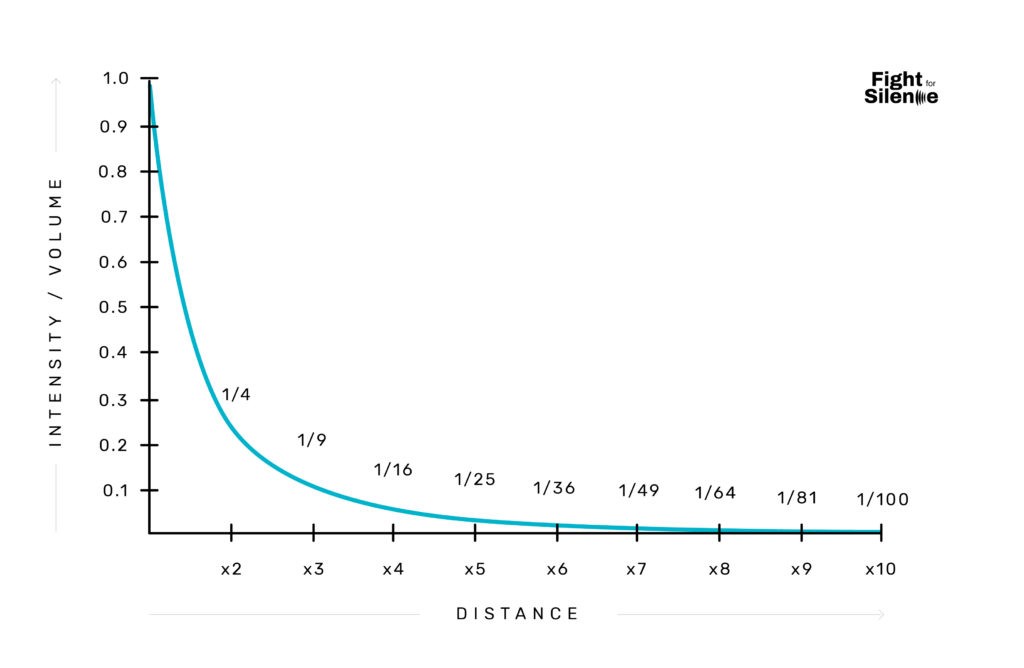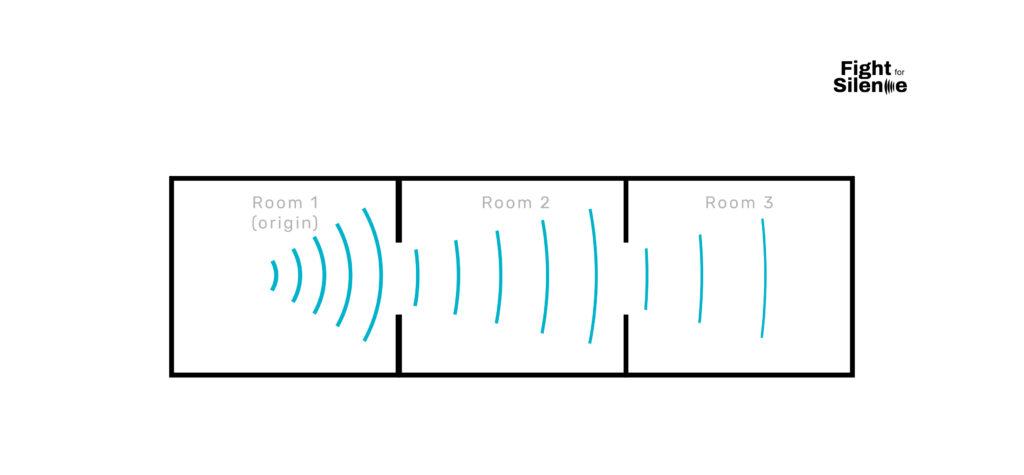
The effect of Distance and other Ambient Factors on perceived volume
When we talk about noise, we mainly care about the noise that reaches us. The sound that reaches us can be very different from the sound at the origin. The distance between us and the source, as well as other ambient factors such as temperature or wind, will have an effect on how sound propagates, and therefore on the sound that we end up perceiving from where we stand at any given point.
There are two important variables to consider. The first is the noise produced at the source. The second is how this noise travels through space, bounces, and dissipates until it eventually disappears.
The former is fairly straightforward, less sound created at a source means less sound propagated out into the world. But how exactly does that propagation work? Is there a way to mitigate noise pollution by targeting how sound propagates?
How does sound propagate?
The first thing to understand about sound propagation is that all sound is caused by some event that puts energy out into the air. This energy is what causes air particles close to the event to vibrate, bump into farther particles, and cause the wave to move farther away from the source of the sound. This energy is related to how loud a sound is; the more energy put into the air, the louder the resultant sound will be.
This is why something like an explosion is so much louder than human speech, as the former has a massive amount more energy compared to the latter.
This energy is what’s carried over from one air particle to the next when they bump into each other. If this transfer were perfectly efficient, meaning that all of the energy of one particle could be transferred to the next, then the volume of the resultant sound would never decrease. Some energy is always lost in the process though, through things like heat transfer and the kinetic energy of individual particles. Although the amount of energy lost between any two particles is incredibly low, these particle-to-particle energy transfers are happening billions of times each second, which means over the course of even a few meters, a noticeable change in the volume of a sound will occur.
How does distance affect the volume of sound?
The amount of sound that dissipates over distance is based on something known as the inverse-square law. As a sound moves over some distance, the area covered by the sound increases fourfold as the distance from the sound source increases twofold.
What this means is that every doubling of distance is a 6-decibel decrease in volume, or a fourfold decrease in perceived loudness. A person 20 meters away from a sound source will hear it four times quieter than a person standing 10 meters from the source.

Ambient factors that cause sound to fade?
Dissipation, or the loss of energy over time as a wave propagates, can be caused by a wide variety of circumstances. As already mentioned, sound waves naturally dissipate over time as they propagate over a distance, but they’ll also dissipate faster depending on some of the attributes of the air they’re passing through.
In general, the more non-sound-related energy is in the air, the faster a sound will dissipate.
In physics, these sources of energy not associated with sound are referred to as noise, so a scientifically noisy room would be one in which the air is filled with a lot of non-sound-related energy, such as a hot breeze. Most of these propagation issues are hard to directly model, since they’re chaotic systems, but there are a few noticeable consistent examples of how noise impacts sound propagation. The speed of sound, for example, is dependent on the temperature of the medium it moves through, and can be up to 15 meters per second faster at room temperature than at freezing temperatures.
Temperature
Hot air, for example, causes a sound to dissipate much faster than cold air, due to the amount of thermal energy in the air.
Wind
This is also true of moving air, such as in a strong breeze, where the air particles have a high amount of kinetic energy.
Physical barriers
Sound also loses some amount of energy when it passes through certain mediums. As mentioned in our article about soundproofing, different materials are more capable of transferring sound than others, but some are also more reflective than others.
Whenever sound interacts with a surface, such as a wall or the ground, some of that energy is passed into the material, while some is also put back into the air as a reflected sound. The ratio of reflected to transferred energy is different for different materials, but in general, the more sound is transferred into a material, the less energy the reflected sound will have, and by extension the quieter it will be. This is why even when a material will cause an echo, that echo will always be quieter than the original sound, no matter how close to the source of the sound the material is.

Since sound transferral also causes a loss of energy, any situation in which a sound has to be reflected several times to reach a listener will also cause a noticeable drop in the volume of the sound. A listener several rooms away from a source of sound will hear that sound as substantially quieter than they would if they were right next to the sound, even if all the entryways between them and the sound are open.

Other sounds
Physical objects aren’t the only thing that can interfere with sound. Sound can also interfere with itself.
Two different sound waves that overlap undergo what is scientifically known as interference, and what actually happens depends on the sounds themselves. Two sound waves that are in phase with each other will build on each other, creating a louder sound. The inverse is also true, two sounds that are out of phase with each other will deconstruct each other, creating a quieter sound (this is the principle used by noise-canceling headphones).
How much two waves will build or deconstruct each other also depends on things like their relative angle to each other and their frequency.

All of these factors cause what is called a chaotic system, which is difficult to model for physicists. What this means is that precisely predicting how a certain amount of noise will impact things like the distance a sound will propagate can be tough, although these factors do have noticeable impacts.
Without diving into highly complex calculations though, we can say that sound will have a harder time propagating on a hot and windy day than it will when it’s chilly and calm outside.
Can sound dissipation be used to our advantage?
Trying to build around sound dissipation is complicated. Everything from the materials that a structure is made from to the distance between walls, or the natural climate of an area can affect how far sound propagates, and by extension how much noise pollution an area has to deal with.
Although on one hand this means that trying to fine-tune the amount of noise in an area can be a never-ending rabbit hole, there are a few general tips that can be taken from the above principles.
- Building residential areas to be spacier will help dissipate sound, not only through distance but through the amount of noise that can build up in the air.
- Using materials that are good at reflecting sound from the outside and absorbing it from the inside can help achieve quieter, more comfortable interior spaces.
- And of course separating noisy industrial zones from residential areas, to allow for natural dissipation, can help ensure that we all live in less polluted soundscapes.

[…] to set ourselves apart from the street or other sources of noise. By doing this we are not only increasing the distance between the noise source and the building, but we are also setting the perfect site for a vegetable […]